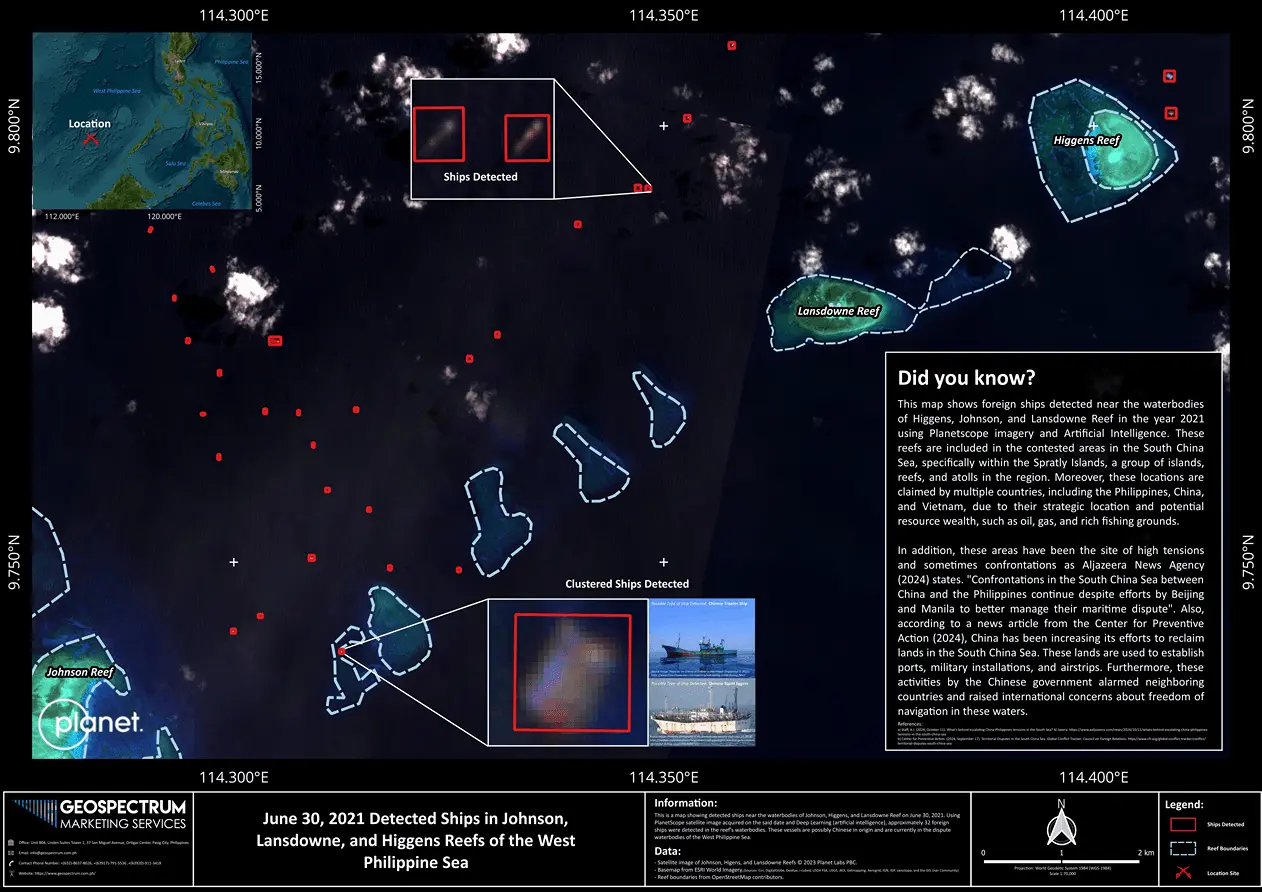Revolutionizing Sea Surveillance: Ship Detection using Deep Learning and PlanetScope Imagery
By David Joshua Santos, Remote Sensing Operations Supervisor
Geospectrum Remote Sensing | Dec 07, 2024
READ TIME: 8 MINUTES
In our increasingly interconnected world, the oceans are emerging as essential
arteries of global trade and communication but also vulnerable to a series of threats ranging from
piracy (Figure 1), and smuggling, to illegal fishing (1). To protect these maritime
lifelines, navies
across the globe are embracing new technology.

Figure 1: Pirates with high-powered guns in the Sulu Sea, Philippines. Ships&Ports (2017).
Conventional maritime surveillance methods like radar and Automatic
Identification System (AIS) have several weaknesses(2). These methods have always been
limited in
detecting small vessels, more so in remote areas. Moreover, adversaries may develop certain tactics
that enable them to remain undetected.
PlanetScope Satellite Imagery: Aiding Global Ship Detection
Satellite images like PlanetScope (Figure 2), with high spatial (up to 3 meters) and temporal resolution (daily capture of images), can visualize the ocean in a bird's-eye view(3). PlanetScope's large fleet of satellites offers near-real-time imagery of the Earth's surface covering vast areas of land and the ocean, greatly surpassing the capabilities of shore-based systems (4).

Figure 2: PlanetScope satellite image of Subi Reef in the West Philippine Sea captured last August 8, 2023.
In addition, using PlanetScope imagery can help capture important ship details such as the size, shape, and even the presence of wakes on ships, which is important for tracking and monitoring ships. This makes AI algorithms capable of identification and classification of these vessels even under unsuitable conditions.
Integrating Deep Learning to Satellite Imagery
Deep learning combined with high-resolution satellite imagery forms a robust solution to such
challenges(5). By analyzing high-resolution satellite data, Artificial Intelligence (AI)
algorithms
can identify ships and track their movements, allowing anomaly detection (Figure 3).
Here in Geospectrum, we develop ship detection modules using PlanetScope imagery and artificial
intelligence (deep learning) that are efficient and cost-effective for securing and monitoring
national maritime borders. Our organization developed a simplified approach to take advantage of
PlanetScope images and artificial intelligence for ship detection.

Figure 3: A sample map showing detected ships in the Johnson, Lansdowne and Higgens Reefs on June 30, 2021 in the West Philippines using PlanetScope Imagery and Deep Learning.
The Importance of Deep Learning and Satellite Imagery
Deep learning, indeed, is the AI branch that is entirely revolutionizing computer vision's landscape (Figure 4). These neural networks were trained upon humongous datasets made of satellite images; the AI model thus learns about patterns and features of a ship, so it would be capable enough to notice vessels properly even in extremely crowded marine traffic or worse weather conditions.

Figure 4: Illustration of Deep Learning adapted from Deep learning V.S. Machine learning of ALLTIUS. ALLTIUS.AI (2024).
How can this developed application help you?
Using the analytics we developed, it can be a powerful tool for military and
naval monitoring and simultaneously enhance your maritime surveillance and security. Here are some
approaches that can be useful for your monitoring:
• Tracking Unauthorized or Suspicious Activity
This technology can help monitor areas prone to
illicit activities, such as illegal fishing, smuggling, and unauthorized incursions into territorial
waters. By comparing detected ships with AIS data, analysts can identify vessels operating without
AIS, which may be attempting to avoid detection (6). For military and naval use, such
unauthorized
activity can trigger investigations, preventing potentially hostile or illegal actions
• Support for Strategic and Tactical Decision
Ship detection systems can provide a clearer picture of maritime traffic patterns, fleet
positioning, and potential security threats. This is invaluable for tactical decisions in real-time,
such as intercepting unauthorized vessels or deploying naval resources in strategic locations.
Long-term data can also support larger strategic decisions about where to allocate resources and how
to position naval assets effectively.
• Operational Advantages in Surveillance of Disputed Regions
In regions like the South China Sea, where territorial claims overlap, monitoring the movements of
foreign vessels or military fleets is crucial. PlanetScope's daily imaging and our ship detection
model can provide continuous insights, helping maintain a balanced stance and deterrence and
supporting diplomatic claims with evidence-based documentation of activities over time.
The Future of Maritime Security
The future of maritime security is being transformed by advancements in satellite imagery and artificial intelligence (AI). Naval forces can enhance surveillance, protect vital maritime infrastructure, and ensure the safe passage of international shipping lanes by utilizing the capabilities of AI and high-resolution satellite imagery like Planetscope. Deep learning, as fused with satellite imagery, is changing the game for maritime security. By offering real-time insights and sophisticated analytics, this technology empowers naval forces to respond in ways that can better confront threats, protect important resources, and maintain the integrity of our oceans(7). These advancements will be essential as we face 21st-century challenges. Are you curious about how our analytics can support your goals? Contact us through email at [email protected] or contact us at +(632) 8637-8026 or +(63917)-791-5536 to learn more about ship detection and PlanetScope imagery. You can also check out our website at www.geospectrum.com.ph to learn more about the products and services we are offering.
References:
1) Kumar, M. (2024). Addressing maritime security challenges through maritime domain awareness: a
study
of the role of the Information Fusion Centre-Indian Ocean Region. Australian Journal of Maritime &
Ocean Affairs, 1–16. https://doi.org/10.1080/18366503.2024.2389680.
2) Brouwer, G. (n.d.). Limitations of current surveillance technologies. Moermanskkade.
https://www.seagullsurveillance.com/never-blink-an-eye-enhanced-maritime-security/limitations-of-current-surveillance-technologies.
3) PlanetScope Overview. (n.d.). https://developers.planet.com/docs/data/planetscope.
4) Planet. (n.d.). Planet Monitoring - Satellite Imagery and Monitoring.
https://www.planet.com/products/satellite-monitoring/
5) Zhao, T., Wang, Y., Li, Z., Gao, Y., Chen, C., Feng, H., & Zhao, Z. (2024). Ship Detection with
Deep Learning in Optical Remote-Sensing Images: A Survey of Challenges and Advances. Remote Sensing,
16(7), 1145. https://doi.org/10.3390/rs16071145
6) Matasci, G., Plante, J., Kasa, K., Mousavi, P., Stewart, A., Macdonald, A., Webster, A., &
Busler, J. (2021). DEEP LEARNING FOR VESSEL DETECTION AND IDENTIFICATION FROM SPACEBORNE OPTICAL
IMAGERY. ISPRS Annals of the Photogrammetry, Remote Sensing and Spatial Information Sciences,
V-3–2021, 303–310. https://doi.org/10.5194/isprs-annals-v-3-2021-303-2021
7) Planet. (n.d.). Maritime and Marine Imagery from Planet Satellite Solutions.
https://www.planet.com/industries/maritime/
8) N.A. (2017). Can China help the Philippines fight Piracy? (Figure 1). Ships&Ports.
https://shipsandports.com.ng/can-china-help-philippines-fight-piracy/
9) N.A. (2024). Deep Learning (Figure 4). Alltius.
https://www.alltius.ai/glossary/what-is-deep-learning




